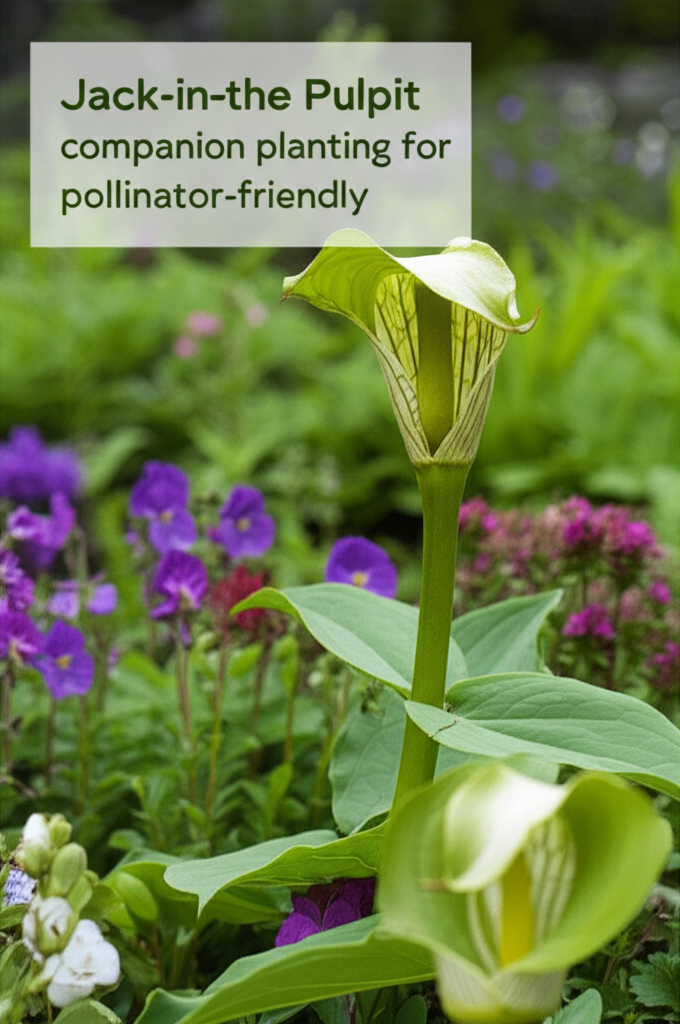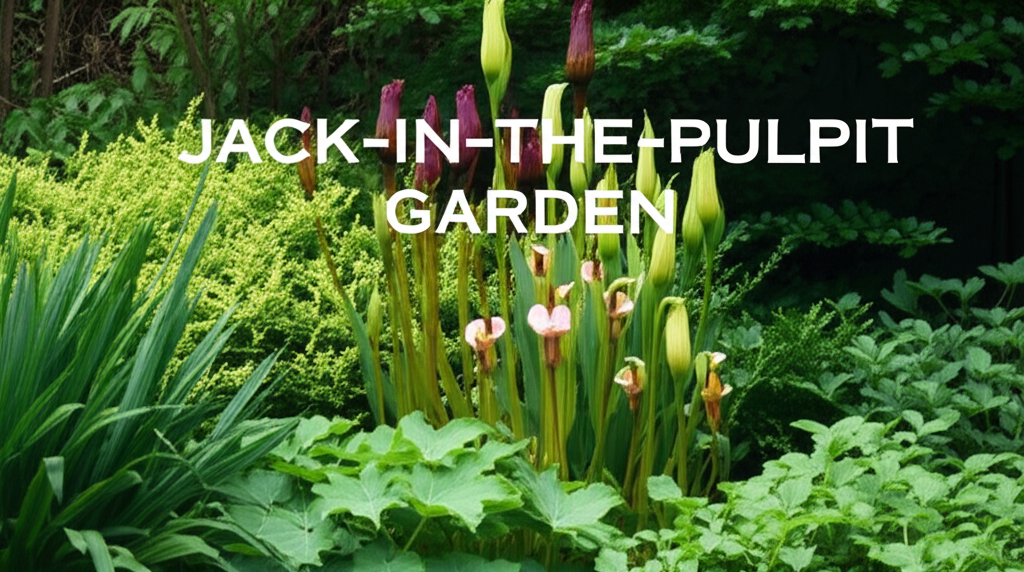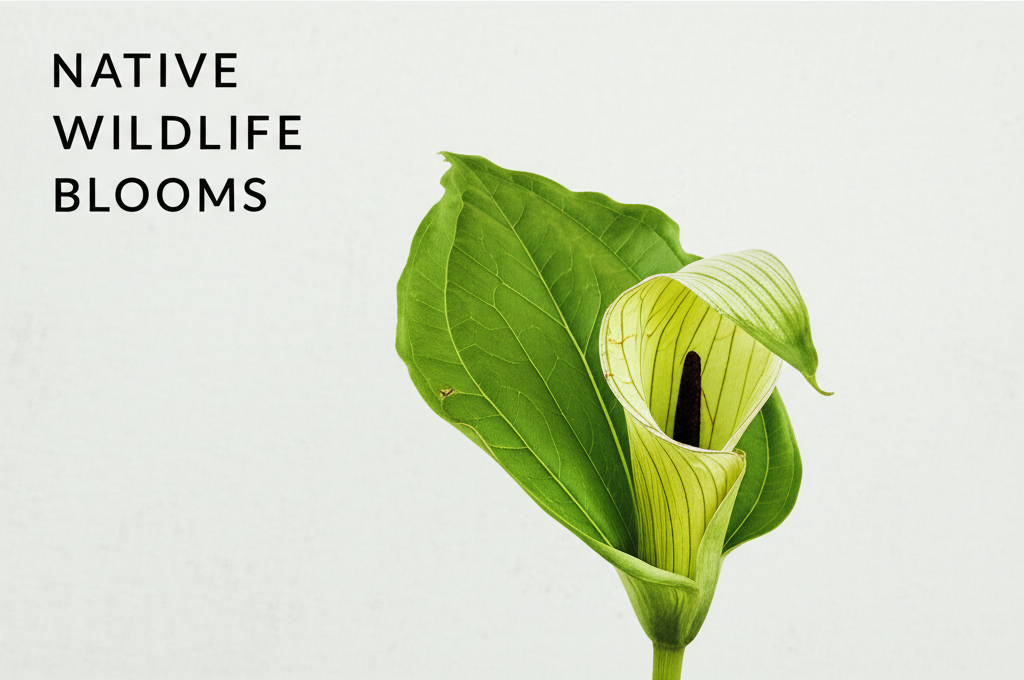Unveiling the Enchanting Jack-in-the-Pulpit for Your Pollinator Garden
The Jack-in-the-Pulpit (Arisaema triphyllum) is a captivating woodland native, renowned for its unique, hooded spathe and spadix inflorescence, often likened to a preacher in a pulpit. Beyond its striking visual appeal, this fascinating plant offers a wealth of benefits for the discerning gardener, particularly those dedicated to fostering thriving pollinator-friendly environments. Understanding its needs and strategically pairing it with companion plants can transform your garden into a vibrant ecosystem buzzing with beneficial insects.
This article will delve into the world of Jack-in-the-Pulpit, exploring its ecological role, its appeal to pollinators, and most importantly, how to cultivate a harmonious and beneficial garden by employing intelligent companion planting strategies. We will uncover the ideal partners for this woodland gem, focusing on plants that not only tolerate similar growing conditions but also actively support the health and abundance of pollinators.
The Allure of Jack-in-the-Pulpit: A Pollinator Magnet
While not as overtly showy as some blooming perennials, the Jack-in-the-Pulpit possesses subtle yet significant attractants for a variety of pollinators. Its specialized flower structure, designed to lure and trap small insects, primarily gnats and small flies, plays a crucial role in its pollination cycle. These tiny insects are drawn in by the spadix’s scent and the spathe’s visual cues.
However, the Jack-in-the-Pulpit’s appeal extends beyond its primary pollinators. Its sturdy stems and unique flower form can provide perching and resting spots for a wider array of beneficial insects, including hoverflies and small bees. Furthermore, the bright red berries that follow the flowering period are a valuable food source for migratory birds, indirectly contributing to the garden’s biodiversity.
Key Facts about Jack-in-the-Pulpit
To effectively incorporate Jack-in-the-Pulpit into your garden, a foundational understanding of its requirements is essential. This knowledge will guide your companion planting choices, ensuring a symbiotic relationship that benefits both plants and the visiting pollinators.
| Attribute | Description |
|---|---|
| Scientific Name | Arisaema triphyllum |
| Common Names | Jack-in-the-Pulpit, Indian Turnip, Bog Onion, Cuckoo-pint |
| Native Range | Eastern North America |
| Light Requirements | Partial to full shade (prefers dappled light) |
| Soil Preferences | Moist, well-draining, humus-rich soil; slightly acidic to neutral pH |
| Bloom Time | Late spring to early summer (typically May-June) |
| Flower Structure | Spadix (finger-like structure) enclosed by a hooded spathe |
| Pollinators Attracted | Primarily small flies, gnats; also attracts hoverflies and small bees |
| Fruit | Bright red berries in late summer/fall |
| Mature Size | 1-3 feet tall |
| Dormancy | Goes dormant in late summer after producing berries |
The Principles of Pollinator-Friendly Companion Planting
Companion planting is an age-old gardening technique that leverages the synergistic relationships between different plant species to create a healthier, more productive, and ecologically balanced garden. When applied to pollinator-friendly gardens, the goal is to attract and support a diverse range of beneficial insects by providing them with continuous food sources, shelter, and breeding grounds.
The core principles guiding companion planting for pollinators include:
- Providing Continuous Bloom: Selecting plants with staggered bloom times ensures that pollinators have a reliable food source throughout the growing season. This means choosing species that flower from early spring through late fall.
- Offering Diverse Food Sources: Different pollinators have different dietary needs. A variety of flower shapes, sizes, and nectar/pollen types will attract a broader spectrum of beneficial insects.
- Creating Shelter and Habitat: Tall grasses, dense foliage, and plants with sturdy stems offer crucial resting, overwintering, and nesting sites for many pollinators.
- Mimicking Natural Ecosystems: Observing native plant communities can provide invaluable insights into successful companion planting. Native plants are often best adapted to local conditions and provide the most reliable support for native pollinators.
- Improving Soil Health: Certain plants, like legumes, can fix nitrogen in the soil, benefiting their companions. Deep-rooted plants can improve soil structure and water retention.
- Pest Deterrence (Secondary Benefit): While the primary focus is on attracting pollinators, some companion plants also possess natural pest-repelling qualities, creating a more resilient garden.
Ideal Companions for Jack-in-the-Pulpit
Given Jack-in-the-Pulpit’s preference for moist, shady to partially shaded woodland environments, its ideal companions will share these conditions. The aim is to create a layered planting scheme that maximizes light interception for blooming plants while providing consistent moisture and shelter for the woodland understory.
Shade-Tolerant Perennials for Continuous Bloom and Pollinator Support
When selecting companions, think about plants that will bloom as Jack-in-the-Pulpit finishes, or those that will offer complementary visual interest and pollinator attraction during its growth cycle.
- Foamflower (Tiarella cordifolia): This low-growing native produces delicate, foamy white flower spikes in late spring to early summer. It thrives in similar shady, moist conditions and its nectar attracts small native bees and flies.
- Columbine (Aquilegia canadensis): The nodding, red and yellow flowers of the wild columbine are a favorite of hummingbirds and long-tongued bees. It prefers partial shade and well-drained soil, making it a good aesthetic and ecological partner.
- Wild Geranium (Geranium maculatum): Blooming with lovely pinkish-purple flowers from spring to early summer, wild geranium provides a nectar source for various bees and butterflies. It tolerates partial shade and moist to dry-mesic soils.
- Solomon’s Seal (Polygonatum biflorum): While not a heavy nectar producer, Solomon’s Seal offers arching stems with drooping white, bell-shaped flowers in spring. Its lush foliage provides excellent ground cover and habitat, and its berries are a food source for birds.
- Ostrich Fern (Matteuccia struthiopteris): This large, architectural fern provides essential shade and retains moisture, creating a perfect microclimate for Jack-in-the-Pulpit. Its fronds offer excellent habitat for insects.
- Woodland Phlox (Phlox divaricata): With its fragrant, pale blue to lavender flowers in spring, woodland phlox is a beacon for early pollinators, including butterflies and bees. It thrives in dappled shade and moist, organic-rich soil.
- Toad Lily (Tricyrtis hirta): Blooming in late summer to early fall, toad lilies offer intricate, orchid-like white and purple speckled flowers. They are excellent for extending the pollinator season in shady areas and attract late-season bees and hoverflies.
Groundcovers and Understory Plants for Habitat and Moisture Retention
Beneath the canopy of larger plants, a layer of groundcover is crucial for suppressing weeds, retaining soil moisture, and providing habitat for ground-dwelling insects.
- Wild Ginger (Asarum canadense): This low-growing native forms a dense carpet of heart-shaped leaves. Its inconspicuous brownish flowers at the base of the plant attract fungus gnats and other small insects. It excels in moist, shady conditions.
- Mosses: Various moss species are excellent companions in deeply shaded, consistently moist areas. They help retain moisture, stabilize soil, and provide microhabitats for tiny invertebrates.
Companion Planting Strategies: Synergistic Benefits
Implementing a well-thought-out companion planting strategy can amplify the benefits for both your plants and the pollinators they support.
| Category | Description | Pros | Cons |
|---|---|---|---|
| Planting Zones | Group plants with similar light and moisture needs together. Jack-in-the-Pulpit prefers moist, shady to dappled light conditions. | Creates healthier, less stressed plants; reduces watering and maintenance; fosters beneficial insect interactions. | May require careful planning to avoid overcrowding; some plants may outcompete others if not managed. |
| Layered Planting | Plant taller species like ferns or larger woodland plants behind shorter ones like foamflower or wild ginger, with Jack-in-the-Pulpit positioned in the mid-ground. | Maximizes light interception for blooming plants; provides visual depth and structure; creates varied microhabitats. | Requires understanding plant mature sizes; potential for shade competition if not balanced. |
| Continuous Bloom Succession | Select companions that bloom sequentially, starting with early spring bloomers and extending into fall. | Provides a consistent food source for pollinators throughout the season; increases garden interest over a longer period. | Requires research into bloom times of various species; may involve some trial and error. |
| Soil Improvement | Incorporate compost and organic matter to enrich the soil, mimicking a woodland environment. Consider plants that improve soil structure or fertility. | Enhances plant vigor and resilience; promotes healthy root development; reduces the need for synthetic fertilizers. | Initial soil preparation can be labor-intensive. |
| Habitat Creation | Include plants with dense foliage, sturdy stems, and leaf litter for overwintering and nesting sites. | Supports the life cycles of diverse pollinator species; increases garden biodiversity; creates a more self-sustaining ecosystem. | May lead to slightly messier appearance if leaf litter is not managed; some plants might attract unwanted insects if not carefully chosen. |
Creating a Pollinator Oasis: Putting it all Together
Designing your Jack-in-the-Pulpit garden is an art form that blends ecological principles with aesthetic considerations. Imagine a tranquil woodland clearing where dappled sunlight filters through a mature canopy. Your Jack-in-the-Pulpit stands proudly in its prime, its unique spathe offering an intriguing focal point.
Around its base, a carpet of verdant wild ginger hugs the moist soil, suppressing weeds and providing a cool, shaded environment. Interspersed are the delicate, foamy blooms of foamflower and the vibrant spurts of color from wild columbine and woodland phlox, drawing in early pollinators.
Behind your Jack-in-the-Pulpit, the elegant arch of Solomon’s Seal adds vertical interest, its bell-like flowers visited by small bees. Towering over them all, the broad fronds of an ostrich fern create a lush backdrop, a haven for beneficial insects seeking refuge and moisture.
As the season progresses and the Jack-in-the-Pulpit’s berries ripen, the late-season blooms of toad lily begin to unfurl, offering sustenance to pollinators as other plants fade. The fallen leaves of these companions will decompose, enriching the soil and creating a self-sustaining ecosystem.
Nurturing Your Jack-in-the-Pulpit and Its Companions
Successful companion planting is not just about initial placement; it requires ongoing care and attention to ensure the health and vitality of your garden.
- Watering: Jack-in-the-Pulpit and most of its recommended companions prefer consistently moist soil. Water deeply and regularly, especially during dry spells, but ensure good drainage to prevent root rot. Avoid overhead watering that can lead to fungal diseases.
- Mulching: A layer of organic mulch, such as shredded bark or leaf mold, is invaluable. It helps retain soil moisture, suppress weeds, regulate soil temperature, and enrich the soil as it decomposes.
- Fertilizing: In most cases, a rich, organic soil amended with compost will provide sufficient nutrients. Avoid synthetic fertilizers, which can harm beneficial soil organisms and pollinators. If a boost is needed, a top dressing of compost in spring is usually sufficient.
- Pruning and Deadheading: While many woodland plants are best left to naturalize, you may wish to deadhead spent flowers on certain companions to encourage reblooming or to maintain a tidier appearance. Remove any diseased foliage promptly. The berries of Jack-in-the-Pulpit are best left on the plant for birds.
- Pest and Disease Monitoring: Healthy plants are less susceptible to pests and diseases. Regularly inspect your plants for any signs of trouble. Companion planting itself often helps deter pests, but if problems arise, opt for organic and least-toxic solutions.
Beyond the Blooms: The Broader Impact
Creating a pollinator-friendly garden with Jack-in-the-Pulpit as a centerpiece is more than just about aesthetics; it’s about contributing to a healthier environment. By providing habitat and food for pollinators, you are supporting the critical work they do in pollinating a vast array of plants, including many of the fruits and vegetables we rely on.
Furthermore, by choosing native plants, you are supporting local biodiversity and the intricate web of life that makes up your region’s ecosystem. A garden that buzzes with life is a testament to thoughtful, nature-inspired design and a commitment to environmental stewardship.
Embracing the Jack-in-the-Pulpit and its carefully selected companions will not only reward you with a visually stunning and ecologically rich garden but also with the profound satisfaction of knowing you are playing an active role in supporting vital pollinator populations. This unique woodland native, when thoughtfully integrated, becomes a cornerstone of a truly vibrant and beneficial garden.


